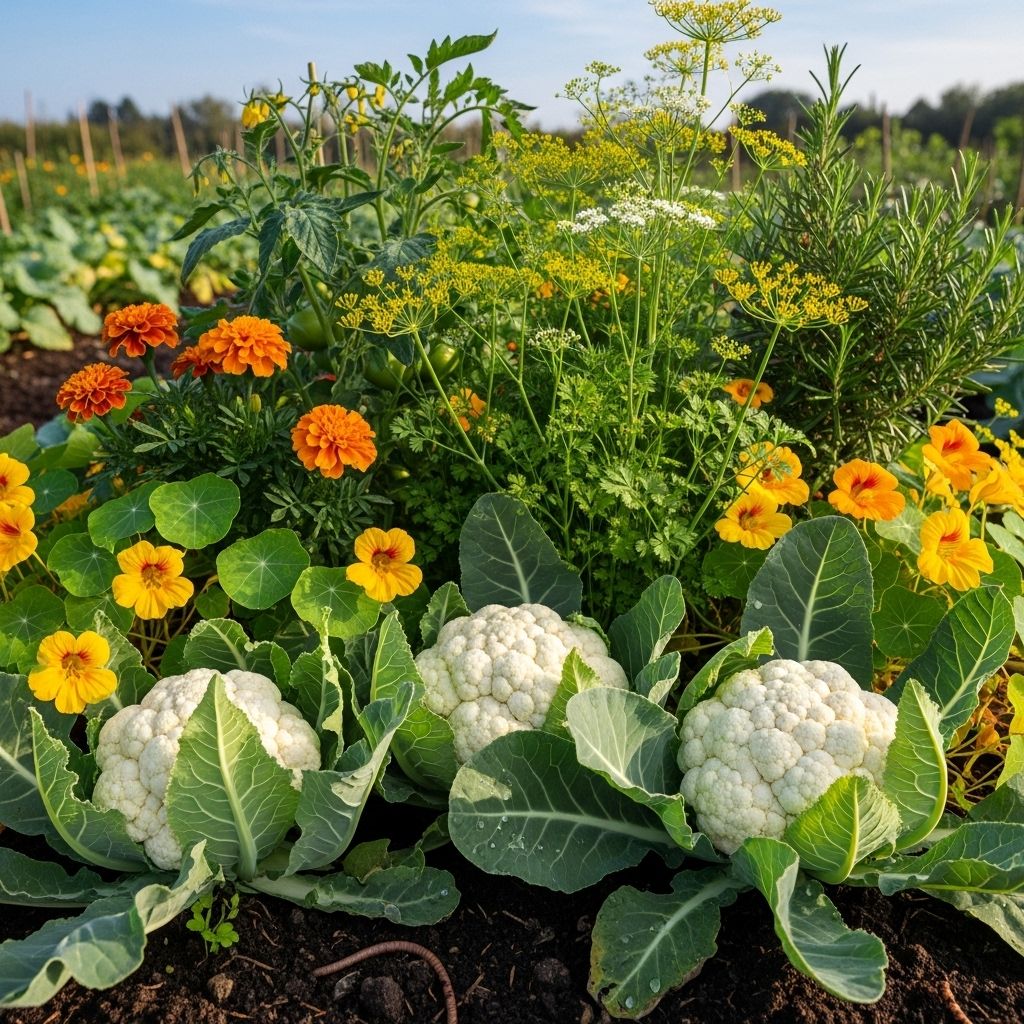Cauliflower Companion Planting: The Ultimate Guide for a Thriving Garden
Strategic garden pairings improve head growth, deter pests, and boost soil vitality.

Image: HearthJunction Design Team
Cauliflower Companion Planting: How to Grow Healthier, Happier Heads
Cauliflower is a member of the brassica family, renowned for its versatility in the kitchen—from crunchy crudités to pizza crusts and stir fry rice substitutes. Though its large leaves might seem to demand space, cauliflower can, in fact, thrive beside a range of garden allies. Smart companion planting helps you maximize harvests, improve plant health, and naturally deter garden pests. In this comprehensive guide, explore the best plants to grow with cauliflower, those to avoid, and essential tips for planting success.
Table of Contents
- What is Companion Planting?
- Benefits of Companion Planting with Cauliflower
- Best Companion Plants for Cauliflower
- Plants to Avoid Near Cauliflower
- Key Tips for Companion Planting Success
- Frequently Asked Questions
What is Companion Planting?
Companion planting is a time-tested gardening technique where different crops are grown in close proximity for mutual benefit. These benefits can include improved growth, pest and disease management, weed suppression, or efficient use of space. When carefully selected, companion plants can help you nurture healthier cauliflower and create a more sustainable, productive garden.
Benefits of Companion Planting with Cauliflower
- Pest Management: Some companions repel cauliflower’s common pests, such as cabbage moths, aphids, and flea beetles.
- Optimal Use of Space: Partnering with plants that have different root depths or growth habits maximizes your garden’s productivity.
- Improved Soil Health: Legumes and nutrient accumulators can help broaden the nutrient profile available to your cauliflower.
- Microclimate Support: Some plants offer shade, wind protection, or living mulch to help cauliflower seedlings get established.
Best Companion Plants for Cauliflower
The right companions boost your cauliflower’s vigor and cut down on problems throughout the growing season. Let’s break down the most effective partners, including brassicas, leafy greens, aromatic herbs, and root crops.
Brassica Relatives
- Broccoli, Cabbage, Kale, Turnip, Brussels Sprouts: Cauliflower grows well with fellow brassicas thanks to their similar soil and watering needs. While planting members of the same family together can sometimes attract pests, close monitoring and coordinated pest control make it possible to reap the benefits of intensive brassica beds—especially in crop rotations.
Leafy Greens and Living Mulch
- Spinach: Fast-growing and shallow-rooted, spinach helps suppress weeds by acting as a living mulch. Both spinach and cauliflower thrive in similar conditions, and can be sown together for efficient use of space, especially early in spring before the weather heats up.
- Swiss Chard: Chard’s upright growth complements cauliflower’s wide spread, and the two harmoniously share moisture and light needs without direct competition.
Root Vegetables
- Beets: Beets and cauliflower have compatible growth rates and won’t compete for above-ground growing room. Because beets aren’t brassicas, they don’t attract the same pests, helping break the cycle of harlequin beetle infestations and other issues.
Aromatic Herbs
- Dill: A classic companion for brassicas, dill attracts pollinators and predatory insects that keep pests such as aphids and cabbage worms at bay. Its preference for similar moisture and sun levels makes it an excellent fit.
- Mint: Mint’s strong aroma can mask cauliflower from pest insects. However, mint can be invasive, so it’s often best grown in containers placed near your brassicas rather than directly in the bed.
Allium Family
- Onions, Garlic, Leeks: The sulfur compounds in allium plants help repel pests such as aphids, mites, and whiteflies. Cauliflower and alliums mature around the same time, making crop planning straightforward.
Beneficial Flowers
- Marigolds: These cheerful annuals attract pollinators and beneficial predators, while their scent deters nematodes and a variety of insect pests.
- Nasturtiums: Often used as a trap crop, nasturtiums lure aphids and cabbage white butterflies away from your cauliflower, reducing the likelihood of infestation.
Celery
- Celery is an ideal partner for cauliflower thanks to their similar water requirements—both need consistent moisture to thrive. Celery’s scent also helps repel white cabbage moths, reducing pest problems naturally.
Other Useful Companions
- Peas: As legumes, peas fix nitrogen in the soil, subtly enriching the ground for nutrient-hungry cauliflower. Since peas finish growing before peak heat, they make a perfect early-season pairing.
Summary Table: Best Cauliflower Companions
| Plant | Key Benefit | Notes |
|---|---|---|
| Broccoli, Cabbage, Kale | Shared growing requirements | Monitor closely for pests/disease |
| Spinach | Weed suppression, early harvest | Living mulch effect |
| Dill | Attracts beneficial insects | Let some flower near cauliflower |
| Onion, Garlic, Leek | Pest deterrence | Works well at bed margins |
| Beet | Disease and pest cycle break | Non-brassica rotation partner |
| Marigold, Nasturtium | Pollinators, pest trap crop | Edge or interplant in beds |
| Celery | Repels cabbage moths | Similar watering needs |
Plants to Avoid Near Cauliflower
Some plants compete with cauliflower for nutrients, attract unwanted pests, or otherwise cause problems. Avoid planting the following near your cauliflower for best results:
- Strawberries: Heavy feeders like cauliflower and strawberries compete for soil nutrients, stunting each other’s growth.
- Tomatoes: Tomatoes and brassicas both want lots of nutrients and space. Intercropping can result in poor yields for both crops.
- Pole Beans: Beans can interfere with cauliflower growth and do not offer reciprocal benefits in this pairing.
- Corn: Tall corn casts too much shade on cauliflower, impeding its ability to grow large, healthy heads.
- Pumpkins, Squash: These sprawling vines can easily shade out and crowd cauliflower, competing for space and light.
Key Tips for Companion Planting Success
- Always allow appropriate spacing for cauliflower, which needs room for its leaves to spread and heads to develop fully.
- Ensure companions have compatible sunlight, water, and nutrient requirements.
- Rotate crops each season to limit disease and pest buildup—avoid planting brassicas in the same spot more than once every three years if possible.
- Monitor for pests and address them early; integrated pest management is crucial in brassica-heavy beds.
- Consider succession planting: grow quick crops like spinach or peas early, then replace with later season partners.
- Mulch to retain moisture, suppress weeds, and keep root zones cool for the best cauliflower quality.
Frequently Asked Questions (FAQs)
Q: Why is companion planting important for cauliflower?
A: Companion planting helps reduce pest pressure, maximize space, and can enhance the flavor and yield of cauliflower by creating a balanced micro-environment.
Q: Can I plant cauliflower with all other brassicas?
A: Yes, as long as you rotate crops annually to minimize the risk of disease and pest buildup. Monitor for issues since they attract similar pests.
Q: What is the best way to prevent pests on cauliflower naturally?
A: Plant aromatic herbs like dill and interplant with onions or garlic to repel common pests. Use flowers such as nasturtiums as trap crops, and encourage beneficial insects.
Q: How much sun do cauliflower and its companions need?
A: Most companions (spinach, alliums, celery, leafy greens) need full sun—at least 6 hours per day—for best results.
Q: Can I grow cauliflower in containers with companions?
A: Yes, use wide, deep containers and pair with compatible, compact companions like spinach, marigold, or onions. Ensure enough space for each crop to thrive.
Conclusion
Thoughtful companion planting brings out the best in your cauliflower, supporting healthier plants, natural pest resistance, and a more abundant harvest. Pair your cauliflower with leafy greens, aromatic herbs, root vegetables, and selected brassica cousins for a thriving, resilient vegetable patch. Avoid problematic neighbors, rotate plantings, and embrace the diversity and beauty that companion planting brings to your garden. Happy growing!
References
- https://www.epicgardening.com/cauliflower-companion-plants/
- https://www.epicgardening.com/basics/companion-planting/
- https://www.gardenersbasics.com/tools/blog/cauliflower-companion-plants
- https://www.littleyellowwheelbarrow.com/cauliflower-companion-plants/
- https://www.thespruce.com/cauliflower-companion-plants-11730407
Read full bio of Anjali Sayee












